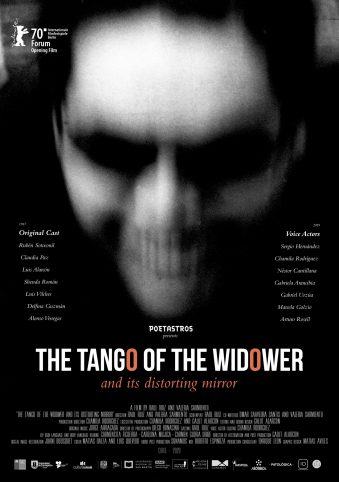 A most eccentric ghost story from the late Raoul Ruiz (1941-2011). THE TANGO OF THE WIDOWER (EL TANGO DEL VIUDO Y SU ESPEJO DEFORMANTE), lensed in 1967, was Ruiz’s first attempt at a feature film, but it was abandoned. The reason, as is all-too-evident in the finished product, was the truncated sound design. It took until 2016, when the footage was discovered in a theater located in Ruiz’s native Chile, for the film to be restored; under the stewardship of Ruiz’s widow Valeria Sarmiento, it was given a proper soundtrack (complete with lip readers and body language specialists employed to figure out what was being said), newly written script additions by the Chilean writer Omar Saavedra Santis and several voice-over actors to re-record the dialogue, and finally completed in early 2020.
A most eccentric ghost story from the late Raoul Ruiz (1941-2011). THE TANGO OF THE WIDOWER (EL TANGO DEL VIUDO Y SU ESPEJO DEFORMANTE), lensed in 1967, was Ruiz’s first attempt at a feature film, but it was abandoned. The reason, as is all-too-evident in the finished product, was the truncated sound design. It took until 2016, when the footage was discovered in a theater located in Ruiz’s native Chile, for the film to be restored; under the stewardship of Ruiz’s widow Valeria Sarmiento, it was given a proper soundtrack (complete with lip readers and body language specialists employed to figure out what was being said), newly written script additions by the Chilean writer Omar Saavedra Santis and several voice-over actors to re-record the dialogue, and finally completed in early 2020.
As is the rule with posthumous director’s cuts (such as Orson Welles’ THE OTHER SIDE OF THE WIND, begun in the 1970s but not completed until over thirty years after its creator’s death), the results are negligible. The film is choppy and discordant, with the major problem being (unsurprisingly) the sound design, which sounds like precisely the pieced-together-decades-after-the-fact hodgepodge it is.
Anyway: the ghost powering the drama is that of the late wife of one Professor Viudo. Her presence is indicated by bodiless wigs moving across and spinning around on Viudo’s floor, feet appearing from under his bed and disembodied hands feeling him up. Viudo does his best to carry on with his normal life in the midst of this oddness, but before long it becomes impossible for him (and us) to discern where “reality” leaves off and the world of the supernatural begins.
All this is filmed largely in close-ups, with a prowling handheld camera constantly moving from peoples’ faces to objects and back. The intent was to keep the viewer in the same disoriented state of mind as the main character, courtesy of the luminous black and white photography by Diego Bonacina.
The ghostly business is pulled off with a fair amount of macabre flair, making one regret that Ruiz didn’t do more in the genre (his subsequent spooky fare includes the uninspired THE TERRITORY and the interesting BLIND OWL). The newly recorded score by Jorge Arriagada actually enhances the eeriness through ominous undertones (many of them accomplished with a Theremin).
Ruiz and Sarmiento also add a number of overtly experimental touches, such as one sequence presented entirely as a succession of still photos (a la JA JETEE and Ruiz’s 1977 short film A DOG’S DIALOGUE) and much of the film’s second half run backwards, with a great deal of what was already shown repeated with the action reversed. I’m unsure what purpose this serves from a dramatic standpoint (an evocation of the tormented mindset of the past-obsessed protagonist, perhaps?), or if it was even part of Ruiz’s original intent.
The distracting inconsistencies in the film stock attest to the fact that this was a posthumously completed production (scenes tend to fade out for no evident reason, after which the action abruptly starts back up in a different location). Obviously we’ll never know what Ruiz was trying for back in ‘67, leaving us with a film that’s interesting, though not entirely satisfying.
Vital Statistics
THE TANGO OF THE WIDOWER (EL TANGO DEL VIUDO Y SU ESPEJO DEFORMANTE)
Poetastros
Director: Raoul Ruiz, Valeria Sarmiento
Producer: Raoul Ruiz, Chamila Rodríguez
Screenplay: Raoul Ruiz, Omar Saavedra Santis, Valeria Sarmiento
Cinematography: Diego Bonacina
Editing: Carlos Piaggio
Cast: Rubén Sotoconil, Claudia Paz, Luis Alarcón, Shenda Román, Luis Vilches, Delfina Guzmán, Alonso Venegas, Sergio Hernández (voice), Chamila Rodriguez (voice), Néstor Cantillana (voice), Gabriela Arancibia (voice), Gabriel Urzúa (voice), Marcela Golzio (voice), Arturo Rossell (voice)
